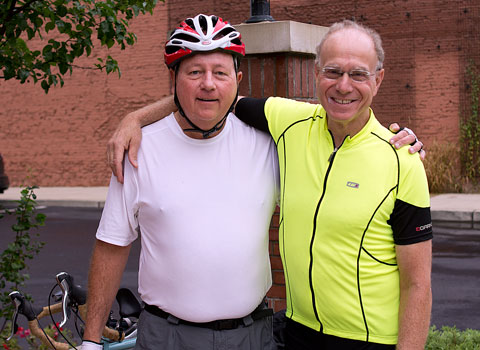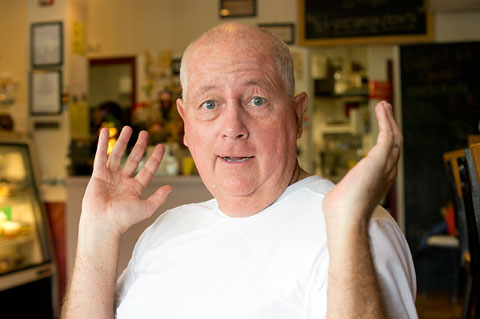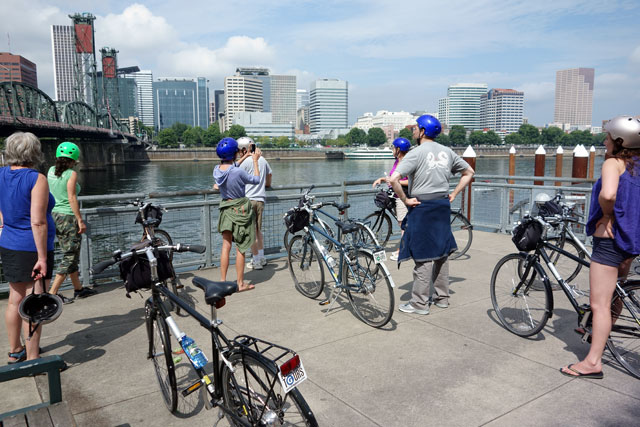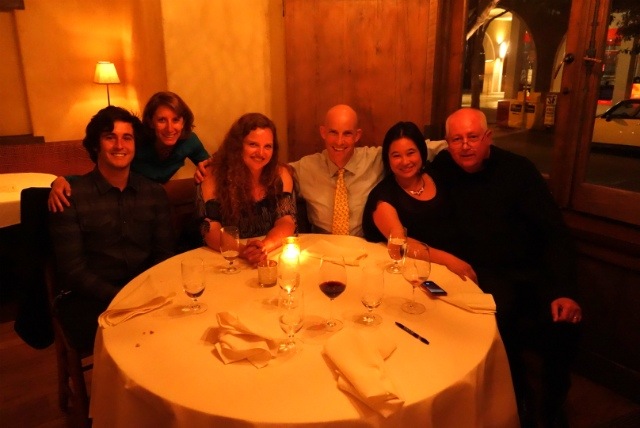The Traumatic End of an Epic Adventure
We had a short ride to Albany, a victory lap is what I’m thinking, but that’s not how things turned out. Instead we’d have our most challenging day of the trip — and more mud!

Our departure from Schenectady was optimistic; it was overcast, but rain seemed unlikely. This was a great relief, of course, as the forecast had predicted rain for days. We found our way to the trail which would be paved all the way to Albany. How sweet.
Our route took us through affluent neighborhoods. Joggers, walkers and a few bike riders dotted the path; it was idyllic. It made me think, this is the wealth GE created; their campus-like facilities bounded the trail. We passed an atomic energy facility, too, which creeped us out a little. We paused to catch our breath at the top of a hill, at the entrance to one well guarded plant, joking, “they’re watching us right now,” and later, every jogger that approached looked ex-CIA to us. We kept moving.

We have time to kill, or so we think; our pace is relaxed as we pedal the darkly canopied trail. I’m focusing on taking a mental picture of this last Day 9 of our epic Erie Canal adventure ride. Everything has been so great; I want to preserve this memory for later recall on some day without as much adventure.
We’re cruising into Watervilet as I begin to fantasize, “I want to find an ethnic neighborhood with a sub shop that toasts their rolls and has great pickles.” Kent offers no fantasies of his own; many times on this trip he’d say I had to work on my fantasies and dream bigger.
Minutes later he’s ahead and pulling to the curb; he’s found a pizza and sub shop in a working class neighborhood; it looks perfect. We’re ahead of the lunch crowd and the food is delicious. We’re basking in the final miles of our trip, only 6 miles to go. We had no clue that it would take 2.5 hours to traverse that final leg and along the way we’d face the most serious challenge of the entire ride. Instead we snap photos as we linger after lunch.

This part of the route has us on a narrow street next to the freeway; it’s not the leisurely route we imagined, so we’re looking at the map to find the off road trail. Turns out we missed it a mile back, which becomes our biggest course correction of the entire trip and a fateful decision — we should’ve kept going along the city streets.
We’d encountered some mud on the trail earlier, but nothing like yesterday’s fiasco. The bikes are looking more like mountain bikes; dirt and grime are everywhere. As we get back on course this off road trail runs between the Hudson River and the freeway we’d been following; it should be quite serene. And that’s how things start. We’re a mile or two down this final path when we hit the first mud flows. We should’ve turned around right then, but retracing our steps, or our pedals in this case, is something we loath doing; maybe it’s the great distance we’ve come, but anywhere along the route, even if we’d just passed the best restaurant in NY, we wouldn’t be inclined to turn around. Next time we will.
Instead we press on. This mud must end shortly I think; we’re in an urban environment, someone must have cleaned up this remnant of Hurricane Irene, but I am sorely mistaken. We get through one stretch and press forward only to encounter another larger field of mud. I go off the trail into the grass thinking the better drainage will make the going easier, but soon there’s so much mud I must dismount and push the bike as I walk through this field of mud that’s beginning to stretch as far as I can see.
Kent’s ahead of me; his looser fitting, minimalist fenders don’t catch the mud and impede his travel, but he’s walking, too and I follow in his footsteps as he looks for the path of least resistance.
Then my rear wheel locks up. The mud and the wet leaves are trapped between the close fitting fenders and my wheel. It’s jammed all along the fender, but especially at the brake pads. I get a stick to scrape the mud away, but there’s little clearance for a stick to get between the fender and the wheel. What a mess. My hands are getting dirty; mud’s falling on the chain and cassette — this isn’t going well. I think to roll the bike backwards and, good idea, a huge clump of mud and pressed leaves rolls out from under the fender where I can kick it off with my increasingly filthy sneakers. I can move again.
But only for a few more steps, the rear wheel is stuck worse this time. I try lifting the bike, but the panniers over the wheel are where all the weight is centered. I can lift it, but forward movement is extremely difficult.
I look up to see where Kent is; he’s on a bit of higher ground, no mud. He’s digging into his panniers and putting on his rain gear. Does he see storm clouds behind us? No, he’s putting on layers to keep the swarms of mosquitoes at bay. On top of everything else, we’re getting eaten alive — I have at least a dozen mosquitoes on me, but I can’t move. Kent comes to help. “Put your rain gear on or you’ll be all welts,” I don’t argue, but surely we’ll be going again in a few minutes I think. It would be hours.
He grabs a stick and together we scrape, but this approach is not going to get us out of here. We press forward, this time he helps — he’s got one hand pushing his bike and one hand lifting up on my saddle as I, too, have a hand on my saddle trying to minimize the drag of the frozen rear wheel. Progress is torturously slow. We’re too far in to turn back now. As we look to the horizon a quarter mile ahead we see something; maybe it’s a way out.
It isn’t. It’s just a couple of picnic tables in a little grove surrounded by more mud. We head for it anyway; we’ll think of something. And we do: the fenders must come off; they’re just trapping too much mud and leaves. The bike isn’t going to go much further unless we get them off. We get out the minimalist tools we brought along. The fender struts pop off in seconds, but the bolt holding the front fender to the fork is tight and the nut is turning as I try to unscrew it. Kent tries pliers to hold the nut, but it slips off 10 times for every 1 time I get a good grip. This isn’t going well. We’ve undone the brakes to get at the bolt and each attempt to unscrew the bolt seems like an opportunity to damage the brake cable. Finally Kent thinks of his tools — he’s got a small set of wrenches and one fits the nut perfectly. We have to take the wheel off to remove the fender, but it’s back on in a minute — the front wheel is free, now the rear.
Off come the panniers and we assess. There’s a lot more going on back here as you know; the fender is bolted to the frame in two places and one of them won’t budge. I can’t unscrew it, but again the wrench saves the day. There’s one more bolt to go, but its nut is blocked by the kickstand. We don’t have a tool to remove the kickstand; this could be challenging. I take the screwdriver to the bolt and turn — thankfully the nut doesn’t turn with it and in a minute the rear fender is off the bike.

We decide to leave the brakes disconnected; it will make it easier to push the bike through the mud. And roll it does — the bike feels 20 lbs lighter. We will survive, no thanks to the mosquitoes who showed no mercy as we conducted this fender-ectomy on the picnic table.
Two hundred yards up the still-muddy trail there’s a clearing to the right. As we approach I can see the freeway clearly, and, was that a car on an exit ramp? It was. Kent goes to check it out. It’s an on/off ramp to the freeway; we should be able to get on it and escape. There’s more nasty mud on the incline as we leave the trail, but we reach the roadway.
Kent decides to go left and follow the exit ramp along an overpass; looks like it will take us out to surface streets. Meanwhile motorists are startled by our disheveled departure as we walk the bikes in the breakdown lane facing oncoming traffic. This is not a good place to be, but we see a way out. After walking half a mile this way we reach the overpass; the roar of freeway traffic below adds stress to our predicament. Kent wonders, “Think we can ride?” My bike’s a total disaster; mud everywhere and I still haven’t connected the brakes. I lean down and get to work; the front brake snaps right in place, but the rear one takes several attempts and as I’m bent over the bike I’m not watching, but I’m well aware of the cars on the ramp zipping by at 70mph. We’ve got to get out of here.
Finally the brakes are on; I climb on and the downhill angle causes the bike to roll, but as I try to pedal I realize the chain is off the front gears. Will the brakes work? Sloppily, but they do; my front brake pads feel worn down, but the bike stops and in no time I loop the chain onto the front gears and this mud saturated, fenderless bike begins moving down the exit ramp. We’re out of the woods and off the freeway. Kent points to a spot across Broadway where we can regroup.
Off comes the rain gear; it saved us from getting eaten alive, but mine doesn’t breath well, so I’m soaked in sweat. The drama is over, but tell that to my pounding heart. This was the most stressful situation I’ve ever faced on a bike. But before I have time to place it in its historical context, it starts raining. We get off the sidewalk onto the roadway and start pedaling; there are only a couple of miles to go.
As I’m moving down Broadway I’m thinking just how durable this bike is — I’ve just put it through hell and it’s shrugged it off and it’s taking me to the finish line. Gotta find another hose. Kent spots a carwash, but it’s self service and there’s no bike lane. We move around the back where we find an auto service business; there’s a spigot on the side of the building. I walk in through the front door, “We’ve had a little emergency; we got stuck on the trail in terrible mud — do you have a hose?” The woman behind the counter must be seeing quite a site. At one point on the picnic table Kent swiped his muddy hand across my face to wipe away a dozen mosquitoes; I was wiping the sweat from my brow with my gloved hand, too. But she wasn’t discouraged by my appearance, I’m sure it led to my credibility. She heads through the door to the service bays to ask the mechanics for a hose; I go out the front door to pray she succeeds. I can see across the giant service floor; she’s got a long hose on a 2-wheeler and she’s walking it straight over, “Maybe take it over to the edge of the parking lot.” We are happy to comply as we begin Day 2 of hosing mud off our bikes.

We’re laughing and joking, because I didn’t want to cry. We were on the verge of another fortuitous outcome, but I felt stressed out of my mind, traumatized. In a few minutes we’re looking good as new and we’ve rolled up the hose and returned it just the way we found it. We pedal away. Too quickly we’re about to discover.
The rain is getting heavier; yesterday we saw it pour around this time of day, but we watched through our hotel window. We’re not sure what this will turn into. Kent’s good with directions; he’s got us on target for the hotel then he pulls over. He left his panniers at the car wash, about 2 miles back. “I’ll come with you,” but he’s moving too fast for me to keep up; I see an overhead where I can pull under and wait. I worry the streets are getting slick and that he’s moving maybe too fast, but all I can do is wait.
He’s back in about 20 minutes. He admits he fell just as he got to the parking lot at the car wash. I can see the raspberry on his elbow, but not the one on his thigh; he’s ok and after a minute to catch his breath we pedal the last 2 miles to the hotel.
The woman at the front desk keeps looking at me and smiling; she’s waiting on someone else, but, again, she sneaks a look and smiles. Then I realize, she hasn’t checked in anyone with mud all over his face in quite awhile.
Another desk clerk agrees to come out and take the end-of-the-ride photos for us, but all 4 shots, using 2 cameras, are focused on everything but us.
Hours later Kent’s son Sam arrives. They’ll take my bike home with them and ship it next week; that way I can get up at 4am and take the first flight home.

This Post Has 2 Comments
Comments are closed.



The updates are great! You paint a vivid picture of the highs and lows of the trip. Fortunately, most of the trip sounded awesome. The story also conveys the ultimate lesson; you can plan all you want, but you can’t prevent the unexpected! Keep up the good work Frank!
Tears of laughter are welling up as I read your post; you’ve caught the adventure perfectly (my memory filtered out the mosquito bites). Had it been a smooth ending to the trek, we wouldn’t have such a good story to tell.